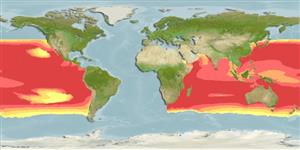Environment: milieu / climate zone / depth range / distribution range
Écologie
marin; océanodrome (Ref. 51243); profondeur 0 - 1830 m (Ref. 86942), usually 0 - 350 m (Ref. 89423). Subtropical; 43°N - 56°S, 20°E - 68°W
Indian and Pacific: tropical and temperate waters. Although some stray individuals are found in the Atlantic Ocean, this species is believed to have its spawning grounds and principal populations only in the Pacific and Indian Oceans. Highly migratory species.
Taille / Poids / Âge
Maturity: Lm ? range ? - ? cm
Max length : 230 cm TL mâle / non sexé; (Ref. 9308); common length : 190 cm TL mâle / non sexé; (Ref. 9308); poids max. publié: 52.0 kg (Ref. 43)
Épines dorsales (Total): 0; Rayons mous dorsaux (Total): 51-57; Épines anales 0; Rayons mous anaux: 18 - 23. Dark blue above, blue splattered with brown on the sides, silvery white below; 1st dorsal fin plain dark blue, other fins brown or dark brown; anal fin bases with tinges of silvery white.
Oceanic and epipelagic, found above the thermocline (Ref. 9308). Feeds on fishes, cephalopods and crustaceans. Also caught as a by-catch of long lines with hooks intended for tuna. Marketed frozen and prepared as fish cakes and sashimi in Japan (Ref. 9308). Also prepared as sausages.
Life cycle and mating behavior
Maturité | Reproduction | Frai | Œufs | Fécondité | Larves
Spawning is believed to occur mainly during the winter months, especially in warm offshore currents with surface temperature of about 25°C.
Nakamura, I., 1985. FAO species catalogue. Vol. 5. Billfishes of the world. An annotated and illustrated catalogue of marlins, sailfishes, spearfishes and swordfishes known to date. FAO Fish. Synop. 125(5):65p. Rome: FAO. (Ref. 43)
Statut dans la liste rouge de l'IUCN (Ref. 130435)
Menace pour l'homme
Harmless
Utilisations par l'homme
Pêcheries: intérêt commercial mineur; pêche sportive: oui
Plus d'informations
RéférencesAquacultureProfil d'aquacultureSouchesGénétiqueElectrophoresesHéritabilitéPathologiesTraitementNutrientsMass conversion
Outils
Articles particuliers
Télécharger en XML
Sources Internet
Estimates based on models
Preferred temperature (Ref.
123201): 13.9 - 28.8, mean 26.2 °C (based on 5116 cells).
Phylogenetic diversity index (Ref.
82804): PD
50 = 0.5630 [Uniqueness, from 0.5 = low to 2.0 = high].
Bayesian length-weight: a=0.00457 (0.00227 - 0.00920), b=3.21 (3.03 - 3.39), in cm total length, based on LWR estimates for this species & (Sub)family-body (Ref.
93245).
Niveau trophique (Ref.
69278): 4.5 ±0.76 se; based on food items.
Résilience (Ref.
120179): Milieu, temps minimum de doublement de population : 1,4 à 4,4 années (Assuming tm=2-4).
Fishing Vulnerability (Ref.
59153): Very high vulnerability (90 of 100).
Climate Vulnerability (Ref.
125649): Moderate vulnerability (45 of 100).
Nutrients (Ref.
124155): Calcium = 35.6 [15.9, 65.1] mg/100g; Iron = 1.07 [0.56, 2.01] mg/100g; Protein = 19.6 [18.3, 20.8] %; Omega3 = 0.296 [0.155, 0.612] g/100g; Selenium = 69.5 [32.9, 148.9] μg/100g; VitaminA = 5.16 [1.47, 18.59] μg/100g; Zinc = 0.345 [0.222, 0.536] mg/100g (wet weight);
